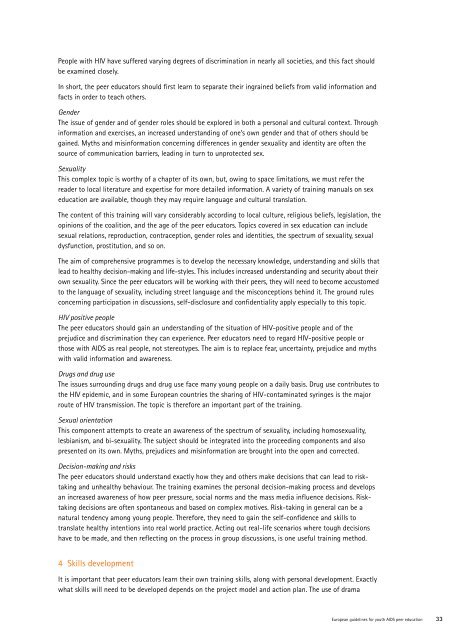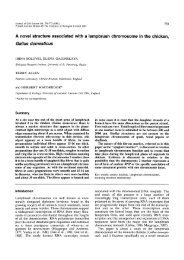European guidelines for youth AIDS peer education - University of ...
European guidelines for youth AIDS peer education - University of ...
European guidelines for youth AIDS peer education - University of ...
- No tags were found...
Create successful ePaper yourself
Turn your PDF publications into a flip-book with our unique Google optimized e-Paper software.
People with HIV have suffered varying degrees <strong>of</strong> discrimination in nearly all societies, and this fact shouldbe examined closely.In short, the <strong>peer</strong> educators should first learn to separate their ingrained beliefs from valid in<strong>for</strong>mation andfacts in order to teach others.GenderThe issue <strong>of</strong> gender and <strong>of</strong> gender roles should be explored in both a personal and cultural context. Throughin<strong>for</strong>mation and exercises, an increased understanding <strong>of</strong> one’s own gender and that <strong>of</strong> others should begained. Myths and misin<strong>for</strong>mation concerning differences in gender sexuality and identity are <strong>of</strong>ten thesource <strong>of</strong> communication barriers, leading in turn to unprotected sex.SexualityThis complex topic is worthy <strong>of</strong> a chapter <strong>of</strong> its own, but, owing to space limitations, we must refer thereader to local literature and expertise <strong>for</strong> more detailed in<strong>for</strong>mation. A variety <strong>of</strong> training manuals on sex<strong>education</strong> are available, though they may require language and cultural translation.The content <strong>of</strong> this training will vary considerably according to local culture, religious beliefs, legislation, theopinions <strong>of</strong> the coalition, and the age <strong>of</strong> the <strong>peer</strong> educators. Topics covered in sex <strong>education</strong> can includesexual relations, reproduction, contraception, gender roles and identities, the spectrum <strong>of</strong> sexuality, sexualdysfunction, prostitution, and so on.The aim <strong>of</strong> comprehensive programmes is to develop the necessary knowledge, understanding and skills thatlead to healthy decision-making and life-styles. This includes increased understanding and security about theirown sexuality. Since the <strong>peer</strong> educators will be working with their <strong>peer</strong>s, they will need to become accustomedto the language <strong>of</strong> sexuality, including street language and the misconceptions behind it. The ground rulesconcerning participation in discussions, self-disclosure and confidentiality apply especially to this topic.HIV positive peopleThe <strong>peer</strong> educators should gain an understanding <strong>of</strong> the situation <strong>of</strong> HIV-positive people and <strong>of</strong> theprejudice and discrimination they can experience. Peer educators need to regard HIV-positive people orthose with <strong>AIDS</strong> as real people, not stereotypes. The aim is to replace fear, uncertainty, prejudice and mythswith valid in<strong>for</strong>mation and awareness.Drugs and drug useThe issues surrounding drugs and drug use face many young people on a daily basis. Drug use contributes tothe HIV epidemic, and in some <strong>European</strong> countries the sharing <strong>of</strong> HIV-contaminated syringes is the majorroute <strong>of</strong> HIV transmission. The topic is there<strong>for</strong>e an important part <strong>of</strong> the training.Sexual orientationThis component attempts to create an awareness <strong>of</strong> the spectrum <strong>of</strong> sexuality, including homosexuality,lesbianism, and bi-sexuality. The subject should be integrated into the proceeding components and alsopresented on its own. Myths, prejudices and misin<strong>for</strong>mation are brought into the open and corrected.Decision-making and risksThe <strong>peer</strong> educators should understand exactly how they and others make decisions that can lead to risktakingand unhealthy behaviour. The training examines the personal decision-making process and developsan increased awareness <strong>of</strong> how <strong>peer</strong> pressure, social norms and the mass media influence decisions. Risktakingdecisions are <strong>of</strong>ten spontaneous and based on complex motives. Risk-taking in general can be anatural tendency among young people. There<strong>for</strong>e, they need to gain the self-confidence and skills totranslate healthy intentions into real world practice. Acting out real-life scenarios where tough decisionshave to be made, and then reflecting on the process in group discussions, is one useful training method.4 Skills developmentIt is important that <strong>peer</strong> educators learn their own training skills, along with personal development. Exactlywhat skills will need to be developed depends on the project model and action plan. The use <strong>of</strong> drama<strong>European</strong> <strong>guidelines</strong> <strong>for</strong> <strong>youth</strong> <strong>AIDS</strong> <strong>peer</strong> <strong>education</strong> 33
















